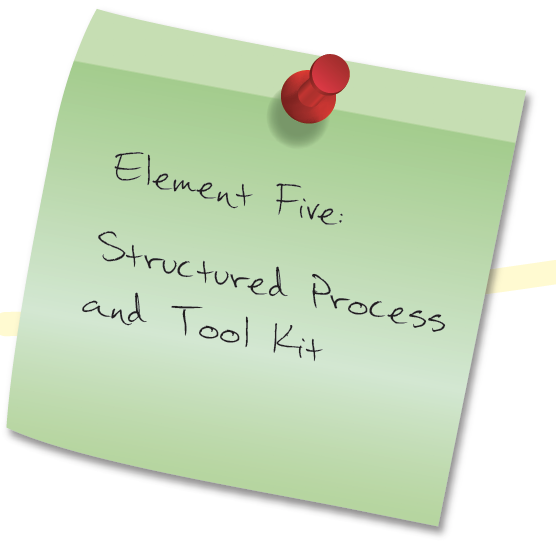
Element Five: Structured Process and Tool Kit
Activities like face-to-face ethnographic research with customers, deep immersion in their perspectives, co-creation with stakeholders, and the design and execution of experiments are not common for managers in any organization. Successful innovation leaders use design’s structured processes to engage these employees, provide them a safe environment for testing new behaviors, and offer them expert coaching to help achieve early, and confidence-building, wins. Creating such an environment enhances employees’ willingness to chance having, and implementing, quality outputs. While designers may find structured processes inhibiting and offputting, people not formally trained in design appreciate guardrails.
Behind the scenes, design’s seemingly simple activities and outputs make possible tricky changes in human behavior that nurture more productive collaboration. Design thinking’s structure provides riskaverse managers with psychological safety, allowing them to check off a step and move to the next one, even if they wonder if they’ve done the step correctly. This structure creates a flow that not only helps managers perform individual activities, it also explicitly links the pieces as part of a larger end-to-end process, keeping novices on track. Equally important, it motivates persistence in the face of heightened ambiguity—always present in innovation.
Using physical props like the ubiquitous Post-It note, and highly structured tools like journey mapping, design thinking moves would-be innovators through orchestrated steps with tangible deliverables in the form of user data, insights, design criteria, ideas, assumptions, prototypes, and experiments. This careful layering of the cognitive complexity of tasks helps non-designers tolerate inevitable uncertainties in creating something that doesn’t yet exist. It saves them from becoming overwhelmed by the famous “messiness” and divergence at the fuzzy front end of innovation as well as by the demands of good hypothesis testing at the back end.
Finally, emphasis on structured processes produces multiple payoffs, improving both innovators’ confidence and solution quality, which are critical to collaborative learning in risk-averse environments. For those operating in complex systems with diverse stakeholder groups, other benefits include helping innovators manage the cognitive complexity of large amounts of information and establishing cause/effect. Seeking the involvement of key stakeholders not on the core design team, especially during sense-making and brainstorming, also builds a sense of ownership that eases later implementation efforts.
Thus, design thinking’s individual elements have a demonstrated potential for fostering better datadriven decision making in the uncertain, multistakeholder environments that usually characterize government work. Taken together, our research suggests these five elements deliver more than the sum of their parts. They also interact with each other to accelerate the upside impact of each individually and thus compensate for weaknesses, and they create a “social technology” that can increase the productivity of conversations for change. In doing this, the bundle of practices and tools under the label of “design thinking” offers the promise of providing new routes to address innovation challenges that stymie government organizations in today’s complex world.




